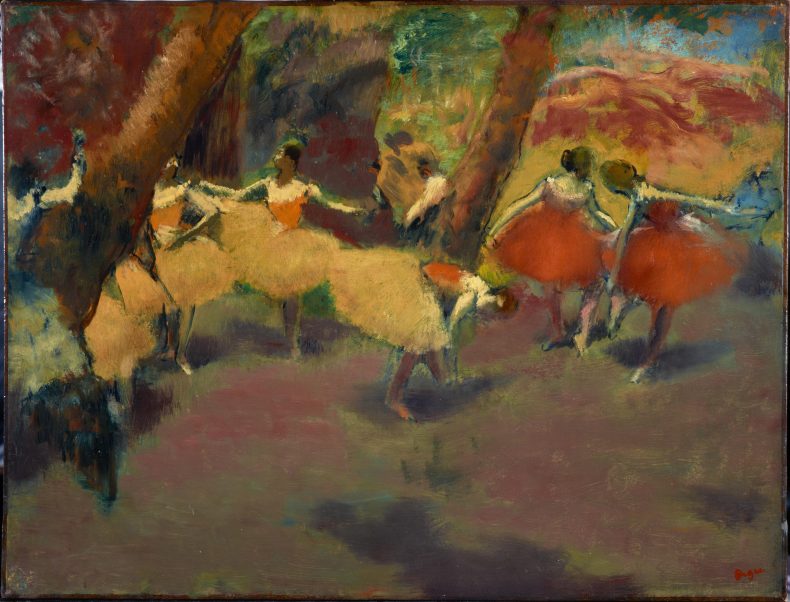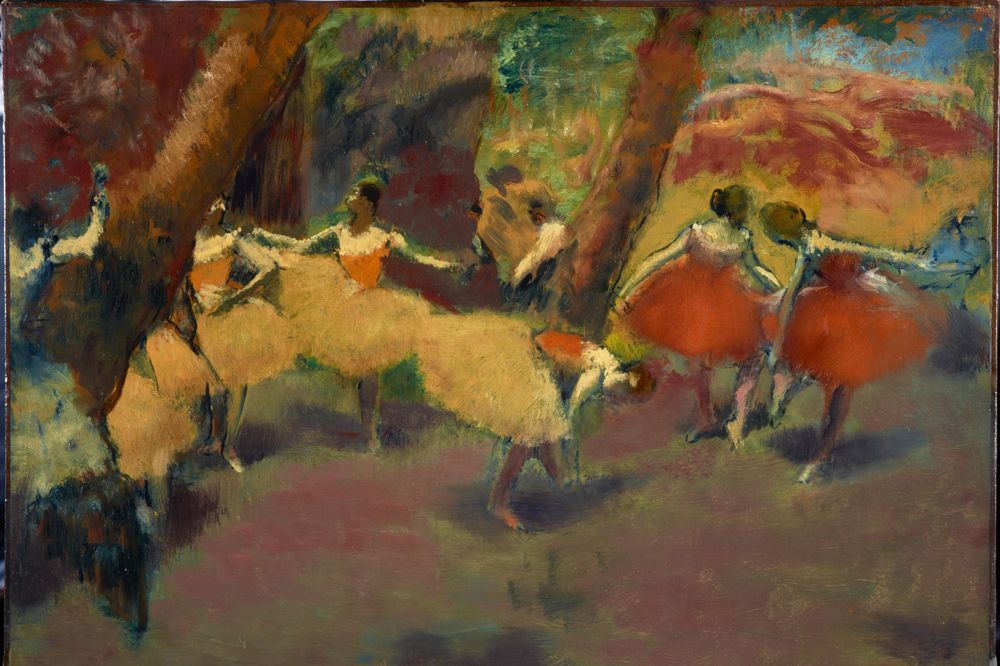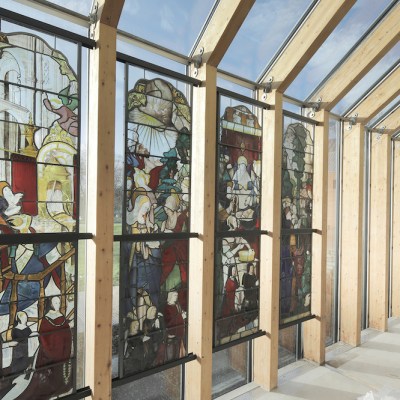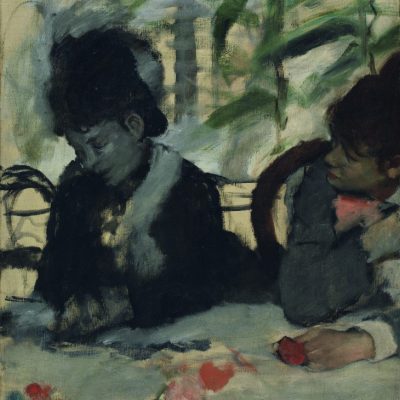When Edgar Degas’s L’Absinthe came up for auction at Christie’s in London in 1892, there were hisses in the saleroom – an incident which tells us at least as much about the sharpening of the British public’s ability to interpret his paintings as it does about late Victorian morals. To an untrained eye, this notorious painting of a slightly slumped and haggard couple sitting in a Parisian café, looking appropriately pensive, doesn’t immediately scream indecency. The Brighton-based collector Henry Hill purchased it in 1876 and exhibited it with the title A Sketch at a French Café, eliciting little reaction. But by the time Hill’s estate was sold at Christie’s, those little visual clues so characteristic of Degas were well understood. That green tinge to the woman’s glass is not light refracting through water. The shadows she and her companion cast at wide angles on the fierce white curtain behind are the product not of the gentle light of late afternoon, but of the coming of dawn. She is probably a prostitute; he might be her companion at the end of a long binge, or he might be in the process of being solicited.
The painting was bought at Christie’s by the dealer Alex Reid on behalf of the Glasgow collector Arthur Kay, who sold it back to Reid a couple of months later, bought it back from him again within 48 hours, allowed it to be exhibited with the more provocative title L’Absinthe at the Grafton Gallery in 1893, and then, most likely fed up with the renewed furore, sold it again to a Parisian dealer the same year. Long housed in the Musée d’Orsay, the painting is now back in Glasgow for the first time in 130 years, on loan to ‘Discovering Degas: Collecting in the Time of William Burrell’ at the Burrell Collection (until 30 September).
The Absinthe Drinker (1875–76), Edgar Degas. Musée d’Orsay, Paris. Photo: © Musée d’Orsay, Dist. RMN-Grand Palais/Patrice Schmidt

This is the first major exhibition to take place in the Burrell since its £68m refurbishment was completed in 2022 – and the first since the terms of William Burrell’s vast bequest of art to the city of Glasgow in 1944 were relaxed, removing restrictions on loans to and from the collection. So the stakes are high – and Degas is a natural choice of subject. Though he never met the artist – a source of great regret – the Glasgow shipping magnate acquired at least 24 pieces by Degas during his lifetime, far more than any other UK collector. Exhibiting for the first time in one place the 23 works he eventually bequeathed to Glasgow would, in and of itself, have been a significant art-historical occasion; they range right the way across the painter’s career, and from ambitious oil compositions to intimate pastels and charcoals.
But Burrell’s collection was by no means comprehensive – nor was it intended to be; as the exhibition makes clear, he wasn’t precious about his collection, selling things on when he needed to (including the first Degas he ever bought, The Encore, in 1894). He never bought a sculpture by Degas, whose talents in that medium became known only after his death in 1917, and he never acquired any of Degas’s experiments in printmaking. And Burrell was only a part, however significant, of the nexus of collectors and dealers who brought Degas to Britain. With precisely chosen loans, the exhibition has deftly managed to round out an excellent overview of Degas while at the same time providing a nuanced exploration of how his reputation in Britain was shaped.
The Ballet Scene from Meyerbeer’s Opera ‘Robert Le Diable’ (1876), Edgar Degas. Victoria and Albert Museum, London

The exhibition opens with a pairing of two works that were among the first by the artist acquired in Britain. Two Dancers on a Stage (1874), one of the earliest instances of Degas’s ballerinas, caught the eye of Henry Hill – a retired quartermaster of the First Sussex Rifle Volunteers, and as such a somewhat unlikely early champion of Degas, though one who had built up a substantial collection of British 19th-century art. On loan from the Courtauld, the painting is coupled with Ballet Scene from Meyerbeer’s Opera ‘Robert le Diable’ (1876), acquired by Hill’s contemporary Brighton-based collector Constantine Ionides (and now in the V&A). Both works demonstrate daring compositional tricks: the former shunts the ballet dancers off to one side, leaving an expanse of bare brown floor; the latter drops us in the pit with the orchestra. They also show how Degas’s predilection for the theatrical went hand-in-hand with his efforts to represent – in the words of Edmond Duranty, the influential critic who placed Degas at the heart of his theory of The New Painting (1876) and whose imperious portrait by Degas was one of Burrell’s prize possessions – ‘the special characteristics of the modern individual’.
Portrait of Edmond Duranty (1879), Edgar Degas. Burrell Collection, Glasgow. Photo: © CSG CIC Glasgow Museums and Libraries Collections

Running like a spine through the show, in a row of plaques leading along the ramp that takes visitors from the upper to the lower galleries, is a roll call of dealers and collectors, ranging from well-known names such as Paul Durand-Ruel, Samuel Courtauld and Hugh Lane to the Aberdonian engineer James Staats Forbes, the English insurance broker Louis Huth and the Dunbartonshire collector Elisabeth Russell Workman. Around this armature, the exhibition is arranged in thematic sections. Scenes of modern life range from a shadowy Woman Ironing – a loan from the Walker in Liverpool – to a fabulously Daumier-like caricature of two gentleman perusing a newspaper, At the Café de Châteaudun, from the National Gallery. Burrell’s outstanding holdings of ballet dancers are supplemented with, among other works, the British Museum’s audacious sketch of Dancers at the Barre (c. 1876–88), their contours dashed down with oil thinned with turpentine on lurid green prepared paper. There are horses at the races, a suite of Ukrainian (formerly known as ‘Russian’) dancers in folk costume; sculptures including a scintillating, subtly polychrome bronze of 1889, The Tub; and a fine selection of Japanese ukiyo-e prints that demonstrates Degas’s compositional debt to this form.
Before the Performance (c.1895/1900), Edgar Degas. National Galleries of Scotland, Edinburgh. Photo: © National Galleries of Scotland

L’Absinthe is the only work to have travelled from France – but that seems fitting. This is about as good a compilation of Degas works drawn from British collections as you could hope for. It is clear that the very qualities that made him stand apart from his fellow Impressionists were the same that ensured his success across the Channel: a preference for figurative compositions; the distinctive force of his classically-trained draughtsmanship. ‘M. Degas alone excepted – impressionism is another name for ignorance and idleness’, declared a critic of an early exhibition in London in 1883, staged by Durand-Ruel. That these qualities made his work easier to read than, say, the plein-air landscapes of Monet also opened him up to a different kind of hostility. In a prelude to the controversy over L’Absinthe, another reviewer in 1883 found him lacking in ‘any appreciation of moral force or moral beauty’. Still, better to be disliked than misunderstood. Degas, for his part, had identified as early as 1875 that ‘this is the moment for me to pull out all the stops in England’. The shrewdness of this gambit is amply borne out here.
The Rehearsal (c. 1874), Edgar Degas. Photo: © CSG CIC Glasgow Museums and Libraries Collections

‘Discovering Degas: Collecting in the Time of William Burrell’ is at the Burrell Collection, Glasgow, until 30 September.



